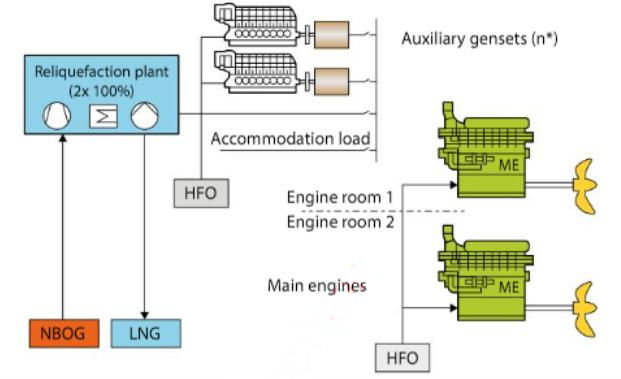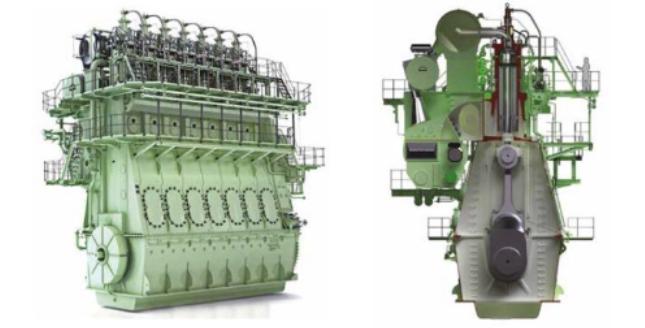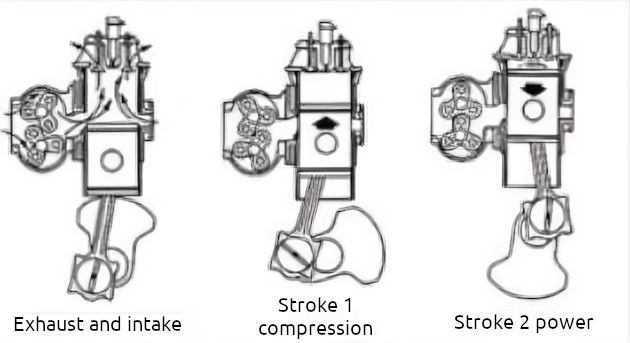Discover the superior efficiency and performance of slow speed marine diesel engines in our comprehensive article. Learn how these engines optimize fuel consumption and reliability, powering the maritime industry into a sustainable future.
Slow-speed diesel (SSD) with a BOG reliquefaction plant
This project specific propulsion system was introduced to the LNG shipping industry in the mid-2000s. Instead of using BOG to generate propulsion and/or electric energy, ships are propelled by conventional 2-stroke low-speed diesel engines and generating sets consuming HFO and marine diesel oil (MDO). The BOG is entirely reliquefied and fed back into the, cargo tanks. A GCU allows BOG to be burned when necessary. This system permits LNG to be transported with no loss of cargo, which can be advantageous depending on market conditions – e. g. if HFO or MDO is comparatively cheaper than utilising BOG for propulsion fuel. During ballast voyages, the cargo tank temperature is maintained by spraying reliquefied LNG back into the cargo tanks, helping reduce the initial increase of BOG on laden voyages. Recently, work has been carried out on the impact of conversion of the 2-stroke diesel engines to dual-fuel diesel engines.

In this propulsion option, the 2-stroke engines utilised are no different from those used in the vast majority of merchant ships utilising the 2-stroke diesel as the propeller prime mover. Typical Types of propulsion systems on ships carrying LNGmarine propulsion plants include a long-stroke, slow-speed, turbocharged, two-stroke diesel engine directly coupled to the ship’s single large diameter, fixed pitch propeller. Dual engine and propeller installations also exist. This configuration can reach quite large power outputs (up to 30-40 MW from a single unit) and yet is characterised by operational reliability due to its conceptual simplicity.

This domination arose from the superior (thermal) efficiency of diesel engines over the other propulsion prime movers. By using alkaline cylinder lubrication oils, large diesel engines can burn HFO. Slow-speed diesel engines are reversible and can be directly connected to the propeller without the need for a gearbox.
The 2-speed diesel engine can burn very low quality fuel (HFO), because the physical space and relative time available for combustion are significantly larger than on a 4-stroke engine. Slow-speed engines are usually built with a smaller number of cylinders and, in consequence, a smaller number of moving parts. This increases the reliability of the propulsion system.
Read also: Exploring Propulsion Systems and Turbo Alternators on Liquefied Gas Carriers
It requires two strokes to complete a power cycle: one stroke down (power stroke) and one stroke up, resulting in one turn of the crankshaft. A 4-stroke must see the piston perform four strokes and two crank rotations to achieve one cycle. On large plants, the two stroke is about 1,8:1 more powerful than a 4-stroke engine of similar weight.
2-stroke engines, as fitted as main propulsion plants on LNGCs, are large, particularly in height, to accommodate the long stroke engine that increases the efficiency of the power stroke. This less complicated design, with no intake valves, reduces the possibility of failure.

The 2-stroke engine is not a naturally aspirated engine. It requires a positive charge of air to fill and scavenge the cylinder and today’s 2-stroke propulsion engines utilise the constant pressure turbocharging system. With this type of turbocharging, the exhaust ports of all cylinders are connected to a common receiver, whose volume is sufficiently large to damp the exhaust pressure pulses, so that one or more turbochargers with a single turbine entry can be used. The main advantages of the constant pressure system are the simple exhaust receiver configuration and the almost steady conditions at the turbine inlet. The disadvantages are inadequate boost pressure at part engine loads and the slow system response.
When starting 2-stroke diesel engines, as fitted on an LNGC, high pressure compressed air is used to overcome the latent inertia and turn the engine. Fuel is also injected into the cylinders. The amount of fuel introduced with the starting air is controlled by an interlock system.

The main parts of a 2-stroke engine are:
- bedplate and crankcase: the bedplate supports the engine and ensures alignment of the crankshaft. The crankcase provides housing for the crankshaft. In large engines, the crankcase and bedplate come in one piece;
- crankshaft and flywheel: the crankshaft is one of the heaviest and costliest components of large marine engines. The flywheel ensures attenuation of the vibrations introduced by the discrete firings in each cylinder;
- engine frame: this part of the engine provides mechanical support for the engine cylinders and ensures the mechanical robustness and flexilbility of the engine structure. Human access to the inner parts of the engine remains possible;
- cylinder blocks and liners: in large marine diesels, each cylinder is contained in its own separate cylinder block;
- pistons and connecting rods: pistons consist of the piston crown, the piston rings and the piston rod. Their role is to deliver mechanical power to the crankshaft, to which they are connected through the connecting rods;
- cylinder heads and exhaust valves: the cylinder heads secure the top of the combustion chamber and provide mechanical support for two other engine components, i. e. the exhaust valves and the fuel injectors;
- camshaft(s): the camshaft, where fitted, is one of the most critical engine parts because it ensures timing of exhaust valves opening/closure, as well as fuel injection;
- fuel system: this is comprised of the high-pressure fuel pumps, the high-pressure pipelines and the fuel injectors (there can be more than one for each cylinder).
Emergency starting of diesel engines:
Although an engine will have many electronic controls for operation, there may also be a lever arrangement fitted for manual emergency starting where the interlocks are mechanically activated.
Electronically controlled, camshaft-less, low-speed diesel engines are now common. For example, the mechanical difference between an “MAN MC-C” engine and its electronically controlled counterpart, the “MAN ME-C” engine, is a number of mechanical parts that are made redundant and replaced by hydraulic and mechatronic parts with enhanced functions. The “electronic” control of the engine fuel injection and exhaust valves and the implementation of advanced diagnostic systems improves low load operation, engine acceleration and gives better engine balance and load control, leading to longer times between overhauls. It also gives lower fuel consumption, lower cylinder oil consumption and improved emission characteristics, particularly with regard to visible smoke and NOx.
An electronic engine has the benefits of ensuring fuel timing and rate as well as exhaust valve timing.
For an electronically controlled engine, the following parts are omitted from a mechanically controlled engine and are replaced by the electronic control system:
- camshaft with cams;
- roller guides for fuel pumps and exhaust valves;
- fuel injection pumps;
- exhaust valve actuators;
- starting air distributor;
- regulating shaft;
- mechanical cylinder lubrication;
- local control stand.
Electronically controlled engines feature fully integrated control of:
- starting air valves;
- start and reversing sequences;
- governor function;
- auxiliary blowers;
- electronically profiled injection control;
- exhaust valve actuation;
- cylinder oil feed rate.
Diesel engines used for ship propulsion are tuned to operate at near steady state on a well-defined operating curve, known as the “fouled-hull” or propeller curve.
2-stroke engines are more popular than 4-stroke engines as main propulsion engines on ships because:
- fuel selection – a 2-stroke engine easily burns low grade fuel oil;
- efficiency – the thermal and engine efficiency of a 2-stroke engine is better than that of a 4-stroke engine;
- power – 2-stroke engines are large stroke engines that produce more power and have high power to weight ratio compared to 4-stroke engines;
- reliability – 2-stroke engines are more reliable (fewer moving parts) in operation as compared to 4-stroke engines;
- less maintenance – the maintenance requirements of a 2-stroke engine are less than that required for 4-stroke engines;
- direction control – direct starting and reversing is simpler with a 2-stroke engine;
- no reduction attachments – 2-stroke engines are low-speed engines and have no requirement for a reduction gear or speed reduction arrangement as required for high-speed 4-stroke engines.
Diesel propulsion offers a CO2 emission reduction of about 30 % when compared to steam turbine propulsion.
| Slow Speed Marine Diesel with Reliquefaction Plant | |
|---|---|
| Advantages | Disadvantages |
| A lot of operator experience in the marine industry | No fuel flexibility, regular bunkering required |
| All shipyards can provide extensive experience for refit | Reliquefaction plants are large power consuming units |
| E/R and cargo systems are totally independent | Require modifications to comply with environmental legislation |
| Simple propulsion plant, common in the marine industry | Not used in multiple projects |
| Direct drive requiring no gearbox and engines are reversible, allowing a more compact engine room and greater cargo capacity for an equivalent ship | Diesel engines require a larger engine room compared to gas turbines |
| Reliquefaction plants now well proven and operator experience is available | GCU as well as reliquefaction plant required |
| 2-stroke engines are large sized, so easier access for maintenance | |
| Less moving parts than 4-stroke engines | |
HFO burning fuel efficient low speed two-stroke diesel engines in single or twin propeller configuration, in combination with reliquefaction of the BOG, offer economic benefits for those trades where loss, i. e. consumption of cargo, is not acceptable as the supply of the full amount of cargo is required.
On LNGCs fitted with reliquefaction systems, the complete amount of cargo (LNG) loaded will not be delivered to the Terminal Operations for LNG or LPG Carrier after Arriving in Portimporting terminal as there are losses of cargo, together with the N2 stream, that have to be ventilated out of the cargo system. (N2 cannot be liquefied because of its lower condensing temperature (minus 196 °C (-196 °C) at atmospheric pressure) when compared to CH4 (minus 161,5 °C (-161,5 °C)).
